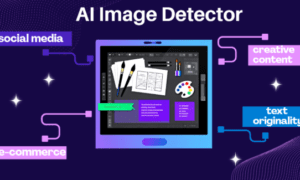In today’s world, artificial intelligence models are an integral part of technological advancement. The implementation and use of these innovative approaches are at the center of attention in a multitude of industries, bringing significant changes. However, behind all the benefits they provide, there are complexities and challenges that require careful consideration and analysis. We will talk about all this with Egger Mielberg, AI developer and founder of Arllecta.
Egger Mielberg, artificial intelligence has been developing rapidly in recent years. What areas have these technologies already penetrated?
It is easier to say where it has not penetrated. AI has had an impact on practically all spheres of life, and its application is becoming wider and more diverse day by day. The technology is in demand in transportation, finance, e-commerce, energy, and manufacturing. AI is being implemented in educational modules, its algorithms are contained in social media, used in organizing customer service, setting up advertising campaigns. Even in creativity, the presence of AI is increasing day by day; it is used to create paintings, write music, compose poetry. In short, artificial intelligence is in demand almost everywhere, from scientific research to everyday tasks. However, it is important to note that not everything that is now presented as AI is actually AI. Much of what is offered on the market actually turns out to be ordinary automated systems, the functionality of which is quite limited.
How then to distinguish real AI?
Most software products demonstrate impressive abilities in solving certain tasks, but they are usually based on predefined rules and patterns. These systems may work efficiently in predictable scenarios, but they lack the ability to adapt to new and unpredictable situations, which is a key feature of true artificial intelligence.
True artificial intelligence is characterized by the ability to learn from data and experience, identify patterns and draw conclusions that have not been pre-programmed. It is able to adapt to changing conditions, make decisions independently, and progress over time. True AI is able to analyze context, extract meaning from complex data, and interact with the environment in a more human-like manner.
While automation can bring significant benefits in certain areas, it is not a substitute for full intelligence to adapt, learn, and understand the world in the broader sense that true AI does.
How long have you been developing artificial intelligence models?
I took my first steps in this direction in 2010, when I decided to start developing my own search engine comparable to Google. However, my task was not only to create another search engine, but also to develop a system capable of understanding the true meaning of user queries. That is, the model was oriented not on a simple search for matches of keywords and phrases, but on the search for contextual connection and meaning of queries. Simply put, the system had to facilitate finding answers that match not only the literal formulation of the question, but also its essence.
As a result, some of the algorithms I developed for this system were sold to Yandex, which proved their value and effectiveness. This experience became a starting point for me for further research and development in the field of artificial intelligence.
Tell us about your most interesting cases?
One of our in-demand developments is related to the Internet of Things technology – a system that monitors the activity of employees at an enterprise. The model monitors the main parameters of employees’ functionality – their location, physical condition, and productivity. In case of deviation from the set standards, the AI analyzes the obtained data, identifies potential causes, calculates the risks of emergency situations and applies appropriate measures. This technology is already being used at large production facilities.
Another model is related to the introduction of an intelligent contact center. The basic idea is that the system focuses on interaction with a person on a semantic level. It seeks to understand the essence of customer requests, and solve their needs without the need to involve an operator. Nowadays, in most cases, bots’ reactions are limited to typical requests; we strive to make our AI capable of solving a wide range of tasks independently, without transferring the dialog to company representatives. This approach allows us to optimize the use of resources and provide better and faster customer service.
What are you working on now?
Right now I am focused on the medical field. My team is developing a diagnostic model that makes it possible to detect cancers at early stages and even prevent the development of malignant tumors. The algorithms we use are based on “semantic connections” – connections between objects of different nature that cannot be identified by traditional methods – neither medical nor traditional mathematical. Conventionally speaking, our system can identify connections between an airplane and, for example, a painting or a bus. If we transfer these tools to the biochemical and molecular levels, we get an interesting result: the occurrence of certain inflammations in humans can be associated with the dysfunction of an organ that is not necessarily located near the place of pain.
What is the practical effectiveness of your development?
Using this approach it is possible to prevent diseases or start treatment at the earliest stages. It is not a secret that now in 60% of cases cancer is diagnosed at the third and higher stages, in which case it is difficult to talk about healing. Of course, this does not apply to all types of cancer, but nevertheless, this situation largely makes the existing diagnostics meaningless, as it is often carried out at late stages of the disease, when effective therapy is difficult. The application of our technology will increase this rate to 99.9%.
This significantly increases patients’ chances of cure, doesn’t it?
Absolutely. Of course, the result of cancer treatment largely depends on the type of cancer, its location, the general condition of the patient and other factors. However, when detected early, treatment of the disease usually has a more favorable prognosis. If we take statistics, then, for example, in the case of cervical, breast and rectal cancer, the chances of recovery when the disease is detected at stage 0 (in situ) and even at stage 1 (localized cancer) are about 90%. For lung cancer, this percentage is usually in the range of 70 to 90. And this is important. Our model has the potential to fundamentally change the approach to diagnosis and therapy of the disease.
What is the main approach to creating this algorithm?
First and foremost, we do not view the model as a software product. Our work is based on extensive and lengthy clinical trials using a biochemical laboratory.
In general, AI is not a program that can be written in a few days. It is based on complex algorithms and models that require deep analysis, development and rigorous testing. It is especially important to pay attention to this when it comes to spheres where human lives are at stake, such as in medicine.
So the development of artificial intelligence implementation requires a long time and thorough expertise? What other challenges stand in the way?
First of all, creating and training complex AI models involves large computing resources, which may not be affordable for many people. Regulatory and standards challenges are relevant. Increasingly, there are questions about who is responsible for mistakes made by AI, and how to ensure proper oversight of systems that can have an impact on human life and safety. Not to forget ethics – the application of new technologies can raise questions about data privacy, discrimination in algorithms, and the autonomy of automated systems. Much excitement is also caused by the uncertainty of the employment sphere – the introduction of AI may lead to job losses, especially in areas where repetitive tasks can be automated.
And what is the main challenge for the AI modeler in such an environment?
I believe there is an inherent need to find a balance between the benefits of AI and its potential risks and negative consequences. This challenge remains important and relevant to both society at large and the scientific community, because the proper use of AI can bring significant benefits, but also requires a thorough understanding and assessment of the potential negative impacts.





























